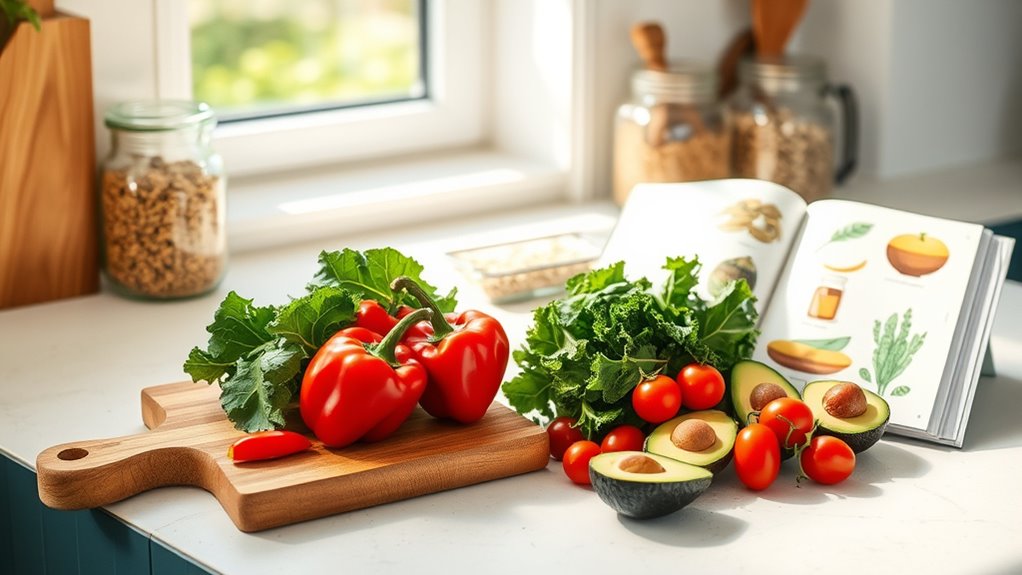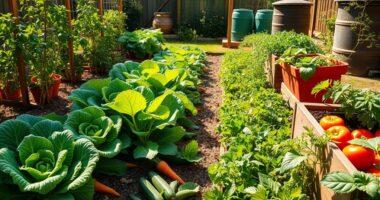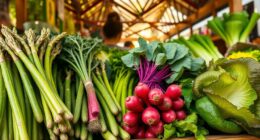To start your plant-based journey, plan your meals ahead and research simple vegan recipes to stay on track. Stock up on dairy alternatives like plant-based milks, cheeses, and yogurts, and be sure to read labels carefully to avoid hidden animal ingredients. Organize your kitchen to make cooking easier and include protein-rich foods like beans and tofu. Celebrate your progress along the way, and if you keep going, you’ll discover more tips to make your progression smoother.
Key Takeaways
- Plan and batch cook meals to simplify your transition and ensure balanced, plant-based nutrition.
- Explore dairy alternatives like plant-based milks, cheeses, and yogurts to replace traditional dairy products.
- Read labels carefully to identify hidden animal ingredients and choose vegan-friendly products.
- Organize your kitchen storage efficiently to streamline meal prep and maintain a clutter-free environment.
- Incorporate a variety of plant proteins and celebrate small milestones to stay motivated and committed.

Are you considering switching to a vegan lifestyle but unsure where to start? It’s a big step, but breaking it down into manageable tasks can make the transition smoother. One of the first things you’ll want to focus on is meal prep. Planning your meals ahead of time helps you stay on track and reduces the temptation to fall back on familiar, less-healthy options. Start by researching simple vegan recipes that suit your tastes, and prepare ingredients in advance. Batch cooking grains, chopping vegetables, and portioning out snacks can save you time during busy weekdays. Having ready-to-eat plant-based meals in the fridge or freezer means you’re less likely to reach for non-vegan convenience foods. Meal prepping also helps you manage your grocery shopping more efficiently, ensuring you buy only what you need and avoid impulse purchases of items that don’t fit your new diet.
Another essential step is exploring dairy alternatives. Many people rely heavily on dairy products, so finding suitable replacements is key for both nutrition and taste satisfaction. Stock up on plant-based milks like almond, soy, oat, or cashew milk, which work well in coffee, cereal, or baking. Try different cheese alternatives, such as nut-based cheeses or those made from coconut oil, to see which textures and flavors you prefer. Yogurt is also easy to replace with soy, coconut, or almond-based options, often enriched with probiotics. Incorporating these dairy alternatives into your meals can help ease the transition by mimicking familiar textures and flavors, making your switch feel less intimidating. Keep in mind that not all dairy substitutes are created equal, so experiment until you find the ones you enjoy most.
As you start exploring vegan products, read labels carefully to identify hidden animal ingredients and choose options that align with your values. Learning to read nutrition labels ensures you’re meeting your dietary needs and avoiding unnecessary additives. Additionally, understanding the importance of vertical storage solutions can maximize your kitchen space and keep your supplies organized. Incorporate more plant-based proteins like beans, lentils, tofu, and tempeh into your meals to keep your diet balanced and satisfying. Remember, transitioning to a vegan lifestyle isn’t about perfection but about making more compassionate and healthier choices over time. Celebrate small victories, like successfully preparing your meals or discovering a new favorite dairy-free cheese, to stay motivated. With a little planning and curiosity, you’ll find that living vegan becomes a rewarding and sustainable part of your life.
Frequently Asked Questions
Can I Be Vegan Without Buying Specialized Products?
Yes, you can be vegan without buying specialized products. Focus on plant-based options like fruits, vegetables, grains, beans, nuts, and seeds during your grocery shopping. These staples are naturally vegan and versatile, making it easy to create delicious meals without needing processed or specialty items. With a little planning, you’ll find plenty of nutritious, satisfying foods that support your vegan lifestyle without extra expense or complexity.
How Do I Handle Social Situations and Dining Out?
When handling social situations and dining out, you should prioritize social etiquette by politely informing others about your vegan choices. Use dining strategies like checking menus beforehand or calling ahead to confirm vegan options. Be flexible and prepared to suggest or bring your own food if necessary. This approach shows respect while making it easier to enjoy meals without feeling awkward or pressured, ensuring a positive experience in any social setting.
Are There Any Health Risks for Beginners?
As a beginner, you might face some health risks like nutritional deficiencies, especially in B12, iron, or omega-3s, and digestive issues if you don’t plan meals carefully. To avoid these, include fortified foods, supplements, and fiber-rich plants. Listen to your body, stay hydrated, and gradually shift to give your digestive system time to adjust. Consulting a healthcare professional can also help you stay balanced and healthy.
What Are Affordable Vegan Protein Sources?
You’ll be surprised how often affordable vegan protein sources come to mind when you’re grocery shopping. Think beans, lentils, and chickpeas—they’re delicious, versatile, and budget-friendly. Quinoa and oats are also excellent plant-based proteins that won’t break the bank. Tofu and peanut butter are convenient options, too. Incorporate these affordable options into your meals, and you’ll easily meet your protein needs without overspending.
How Do I Deal With Cravings for Non-Vegan Foods?
When cravings for non-vegan foods hit, try healthy snack ideas like nuts, fruit, or veggie sticks to satisfy your hunger. Practice mindful eating techniques by paying attention to your body’s signals and savoring each bite, which can reduce the urge for less healthy options. Drinking water or herbal tea can also help, and remind yourself of your plant-based goals to stay motivated.
Conclusion
Now that you’ve got your map, your journey into the plant-based world is just beginning. Embrace each step like adding vibrant colors to your canvas, turning every meal into a masterpiece. Remember, this path is yours to explore, full of lush gardens and new flavors waiting to bloom. Stay curious, be kind to yourself, and let your passion blossom. Before long, your vegan adventure will flourish into a beautiful, nourishing story you’re proud to tell.










